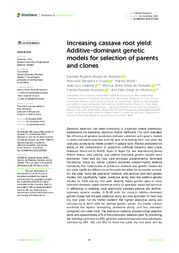Increasing cassava root yield: additive-dominant genetic models for selection of parents and clones.
Increasing cassava root yield: additive-dominant genetic models for selection of parents and clones.
Author(s): ANDRADE, L. R. B. de; SOUSA, M. B. e; WOLFE, M.; JANNINK, J. L.; RESENDE, M. D. V. de; AZEVEDO, C. F.; OLIVEIRA, E. J. de
Summary: Genomic selection has been promising in situations where phenotypic assessments are expensive, laborious, and/or inefficient. This work evaluated the efficiency of genomic prediction methods combined with genetic models in clone and parent selection with the goal of increasing fresh root yield, dry root yield, as well as dry matter content in cassava roots. The bias and predictive ability of the combinations of prediction methods Genomic Best Linear Unbiased Prediction (G-BLUP), Bayes B, Bayes Cr, and Reproducing Kernel Hilbert Spaces with additive and additive-dominant genetic models were estimated. Fresh and dry root yield exhibited predominantly dominant heritability, while dry matter content exhibited predominantly additive heritability. The combination of prediction methods and genetic models did not show significant differences in the predictive ability for dry matter content. On the other hand, the prediction methods with additive-dominant genetic models had significantly higher predictive ability than the additive genetic models for fresh and dry root yield, allowing higher genetic gains in clone selection. However, higher predictive ability for genotypic values did not result in differences in breeding value predictions between additive and additive-dominant genetic models. G-BLUP with the classical additive-dominant genetic model had the best predictive ability and bias estimates for fresh and dry root yield. For dry matter content, the highest predictive ability was obtained by G-BLUP with the additive genetic model. Dry matter content exhibited the highest heritability, predictive ability, and bias estimates compared with other traits. The prediction methods showed similar selection gains with approximately 67% of the phenotypic selection gain. By shortening the breeding cycle time by 40%, genomic selection may overcome phenotypic selection by 10%, 13%, and 18% for fresh root yield, dry root yield, and dry matter content, respectively, with a selection proportion of 15%. The most suitable genetic model for each trait allows for genomic selection optimization in cassava with high selection gains, thereby accelerating the release of new varieties.
Publication year: 2022
Types of publication: Journal article
Unit: Embrapa Coffee
Keywords: Breeding value, Cassava, Clones, Genomics, Natural selection, Plant breeding
Observation
Some of Embrapa's publications are published as ePub files. To read them, use or download one of the following free software options to your computer or mobile device. Android: Google Play Books; IOS: iBooks; Windows and Linux: Calibre.
Access other publications
Access the Agricultural Research Database (BDPA) to consult Embrapa's full library collection and records.
Visit Embrapa Bookstore to purchase books and other publications sold by Embrapa.

